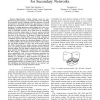Free Online Productivity Tools
i2Speak
i2Symbol
i2OCR
iTex2Img
iWeb2Print
iWeb2Shot
i2Type
iPdf2Split
iPdf2Merge
i2Bopomofo
i2Arabic
i2Style
i2Image
i2PDF
iLatex2Rtf
Sci2ools
134
click to vote
INFOCOM
2012
IEEE
2012
IEEE
Truthful spectrum auction design for secondary networks
Abstract—Opportunistic wireless channel access by nonlicensed users has emerged as a promising solution for addressing the bandwidth scarcity challenge. Auctions represent a natural mechanism for allocating the spectrum, generating an economic incentive for the licensed user to relinquish channels. A severe limitation of existing spectrum auction designs lies in the oversimplifying assumption that every non-licensed user is a singlenode or single-link secondary user. While such an assumption makes the auction design easier, it does not capture practical scenarios where users have multihop routing demands. For the first time in the literature, we propose to model non-licensed users as secondary networks (SNs), each of which comprises of a multihop network with end-to-end routing demands. We aim to design truthful auctions for allocating channels to SNs in a coordinated fashion that maximizes social welfare of the system. We use simple examples to show that such auctions among SNs dif...
Related Content
| Added | 28 Sep 2012 |
| Updated | 28 Sep 2012 |
| Type | Journal |
| Year | 2012 |
| Where | INFOCOM |
| Authors | Yuefei Zhu, Baochun Li, Zongpeng Li |
Comments (0)

